 |
|

|
 |
TABLE of CONTENTS
 |
Magazine names Winona Bridge one of North America's top 10 bridges |
By Mike Dougherty, District 6 public affairs coordinator

Tory Thompson, a senior engineer with MnDOT, foreground, visits the Winona Bridge construction site on Dec. 2 with a Rochester Post-Bulletin reporter. Photo by Mike Dougherty |
The Winona Bridge was named as one of the top 10 bridges of 2015 in the November issue of Roads and Bridges magazine.
Each year the magazine’s editorial staff recognizes the top projects in North America based on project challenges, impact to the region and scope of work.
The Winona Bridge project was selected as No. 7. The project includes construction of a new concrete box girder design crossing and rehabilitation of the current historic bridge. It was featured on the cover of the edition. Editors noted the use of the Construction Manager/General Contractor method, an integrated approach to planning, designing and constructing a project. They also noted the enhanced pedestrian features for the new bridge.
The South Park Bascule Bridge replacement in Seattle, Washington, was ranked No. 1. The rankings can be found at: www.roadsbridges.com/awards/top-10-bridges.
The Dresbach Bridge, downriver from Winona, is also under construction and was named as one of the top 10 bridges of 2013.
The new $79.6 million Winona Bridge is expected to open to traffic in late 2016 and then work will begin to rehabilitate the existing bridge. The new bridge will be 2,295 feet, which includes a 450-feet main span over the Mississippi River channel. Construction continues through the winter.
The 2008 Legislature provided $2.5 billion over 10 years to replace or repair the state’s fracture critical and structurally deficient bridges. The Winona Bridge project is being funded as part of this Chapter 152 program.
The Winona Bridge project is the first for MnDOT using the Construction Manager/General Contractor delivery method. In the CMGC process, the project owner hires a contractor to provide feedback during the design phase before the start of construction. It’s an alternative contracting method to Design-Bid-Build or Design-Build.
The benefits of the CMGC process are:
- Fosters innovation
- Allows flexibility
- Improves cost control and cost certainty
- Produces fewer change orders and overruns
- Yields higher design quality
- Reduces risk
- Optimizes schedules
- Enhances collaboration
In the CMGC bid process, an independent cost estimator separately estimates the costs for different parts of the construction, to compare with the bid the CMGC submits. The CMGC’s bid must be within 10 percent of the independent cost estimator in order to be accepted.
Follow construction progress on the project website at www.mndot.gov/winonabridge, by signing up for email updates, or by visiting the project Facebook page at www.facebook.com/WinonaBridge. |
 |
|

|
 |
TABLE of CONTENTS
 |
Pull-off lanes on Hwy 61 receive applause |
By Marcia Lochner, Office of Freight & Commercial Vehicle Operations
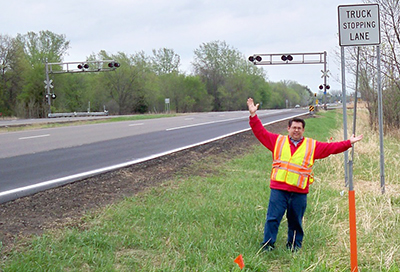
Dave Johnson, transportation director for White Bear Lake School District, expresses his appreciation for the recently installed pull-off lanes at the Hwy 61 and Canadian Pacific Railroad crossing. Johnson sent this photo and thank you to MnDOT for installing these lanes. Photo courtesy of White Bear Lake School District |
“Thank you, thank you, thank you,” were the words Dave Johnson, transportation director for the White Bear Lake School District, used to express his gratitude toward MnDOT for installing pull-off lanes at the railroad crossing on Hwy 61, just north of Hwy 96. The school district has more than 50 buses that drive through this crossing daily.
By law, commercial vehicles and school buses must stop at all railroad crossings. However, if there is not a dedicated pull-off lane, Minnesota statute prevents them from using the shoulder so they must stop in the through lane of the highway. To address safety concerns at this crossing, which previously had no place for stopping other than the through lane, Johnson contacted MnDOT’s Office of Freight and Commercial Vehicle Operations to inquire about the possibility of adding truck/bus pull-off lanes.
After receiving Johnson’s concerns, OFCVO initiated discussions with the Metro District to find a way to add pull-off lanes at this railroad crossing. Dale Gade, Metro project development and Gayle Gedstad, Metro traffic office, met with Johnson and OFCVO at the site. After reviewing the situation and garnering Metro District buy-in, efforts began to fund and administer the project.
“OFCVO and Metro worked together to make this low-cost, high-impact safety enhancement a reality,” said Jim Weatherhead, Metro Area project manager in the Office of Freight and Commercial Vehicle Operations. “OFCVO used Federal Section 130 railroad grade crossing safety funds to pay for the project’s construction and Metro staff provided the design work and construction administration using Metro operations budget.” |
 |
|

|
 |
TABLE of CONTENTS
 |
Leaders broaden their knowledge in Manager Rotation Program |
By Rich Kemp

As part of the Manager Rotation Program, former Transportation Ombudsman, Deb Ledvina accepted a rotation assignment serving with the Office of Freight and Commercial Vehicle Operations. Photo by David Gonzalez |
The latest round of the agency’s Manager Rotation Program started in September with Deb Ledvina accepting an assignment serving with the Office of Freight and Commercial Vehicle Operations in the Modal Planning and Programming Division.
Ledvina has been with the department for more than 23 years, the last seven serving as the Transportation Ombudsman. She is not new to the modes. She spent the first half of her MnDOT career in at least three different modal offices and is looking forward to this rotational assignment. Ledvina’s office is located on first floor of the Transportation Building and her new number is 651-366-3686.
The rotation program provides established MnDOT managers with the opportunity to broaden their knowledge of the agency by working in an area they might not otherwise have a chance to experience.
“There are so many benefits to the Manager Rotation Program,” said Eric Davis, MnDOT chief of staff. “The cross-training is helpful to managers who gain and share insights across functional areas. When leaders better understand the expectations and functions of other managerial roles in the agency, it makes it easier to appreciate both the importance and challenges of different functional areas, which can lead to improved cooperation and innovation.
"Further, rotation assignments are helpful to any manager seeking a change or a new challenge. Even a temporary change in role can often raise morale and renew a sense of pride and value to the organization by better understanding multiple roles,” Davis said.
Joe Pignato and Deb Anderson are exchanging manager positions for six months. Anderson will be assuming Pignato’s position as the assistant director of Land Management, Real Estate and Policy Development, and Pignato will be assuming Anderson’s position as the manager of Metro District Right of Way.
"This is a great opportunity for Engineering Services and Operations Divisions to learn from each other and share ideas," said Bryan Dodds, Office of Land Management director.
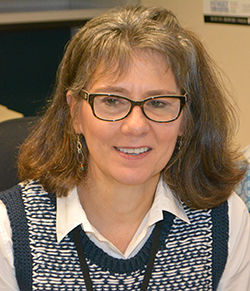
Deb Anderson is rotating to the position of assistant director of Land Management, Real Estate and Policy Development as part of the Manager Rotation Program. Photo by Rich Kemp |
Pignato has 18 years of experience with MnDOT in Consultant Services, Utilities, and Right of Way. He has taken advantage of mobility opportunities in the past, working in the areas of Streamlining, Government Affairs and as a West Metro area engineer. Previous to MnDOT, he worked 10 years for LHB Engineers and Architects, Inc., as a consultant engineer. Pignato is now at the Metro District Right of Way office located on the 4th floor of Water’s Edge in Roseville. His phone number is 651-234-7551.
Anderson has been with MnDOT for more than 30 years. She started her career as a graduate engineer in District 8 and then was hired as the District 8 Right of Way engineer. In 1989, Anderson was hired by the Metro District and worked primarily in Right of Way and Design. Her new office is on the 8th floor of the Transportation Building in the Office of Land Management. She can be reached at 651-366-3503.

Terry Humbert started Nov. 18 in a rotation as the portfolio manager in the Operations Division. Photo by Rich Kemp |
Terry Humbert, assistant district engineer for program delivery in District 3, and Ed Idzorek, portfolio manager in the Operations Division, have switched positions for approximately nine months. They made the switch on Nov. 18.
Humbert started with MnDOT in 1985 as a graduate engineer in Willmar. He worked for eight years in the Metro District in design and pre-design, before moving to District 3. He spent 21 years in District 3 in planning and project development. His office is on the 4th floor of the Transportation Building and he can be reached at 651-366-3756.
Idzorek began working at MnDOT in 1997 in District 3’s Planning and Preliminary Design Section. He moved to the Office of Investment Management, now Capital Programs and Performance Measures, in 1998. He also has worked in District 7 and Metro Project Delivery. Idzorek is working out of the District 3 St. Cloud Office. His phone number is 320-223-6527.
“This is a great opportunity for them, as well as the teams and department,” said Mike Barnes, Operations Division director. “The managerial mobility program has had great success with participants and their supervisors saying that it has given them a new perspective and additional knowledge of MnDOT. I hope more managers will look for these types of opportunities.” |
 |
|

|
 |
TABLE of CONTENTS
 |
MMB launches new online job application system |
|
By Judy Jacobs
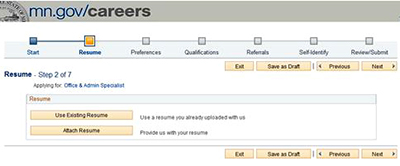
A new application system to search and apply for current state job openings went online Dec. 8. |
Minnesota Management and Budget rolled out a new application system Dec. 8. Recruiting Solutions is an Oracle software program that replaced the Resumix system previously used to apply for state jobs. This new state-of-the art system was designed to be more user friendly and offer a better job search and application experience for anyone searching the site and applying for current job openings.
MMB started a “soft launch” of the system Nov. 23. The soft launch allowed Human Resources employees to begin drafting future job postings in Recruiting Solutions. All job postings within Resumix closed on Dec. 4.
Applicants applying for positions with the new system can:
- Upload a unique and tailored resume for each job
- Automatically fill in portions of their application by uploading their resume
- Identify their qualifications by answering simple questions
- Reset their user ID and password automatically
- Track where they are in the application process
- Sign up to receive notifications about new openings
Resumes and information in Resumix were not transfered to the new system and applicants are no longer able to access the Resumix system after Dec. 4.
“We are really excited about this new job application system,” said Karin van Dyck, Human Resources director. “This is such an important milestone in our efforts to attract, hire and retain the very best. It also serves as a model of continuous improvement and excellence in service.”
Current state employees can access and apply for positions by going through Self Service. It is the only way that employees can see job postings open to state employees. Direct applicant callers can use the job line at 651-259-3637 or the careers email box at www.mn.gov/careers to search and apply for openings. Contact your HR representative with any questions.
MMB plans to ask for feedback from system users in an effort to make any necessary improvements to the system. |
 |
|

|
|

|
 |
TABLE of CONTENTS
 |
Enrollment opens Dec. 14 for Leadership Development Program |
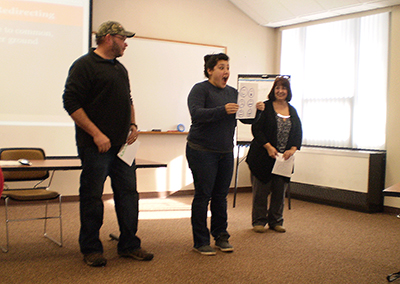
From left: Don Horman, District 6; Bri Alsides, Metro District; and Candy Harding, State Aid Finance, participate in a communications exercise during a Leadership Development Program class. Photo by Shawn Meade |
Employees who are looking to develop a broader knowledge of MnDOT and work on their leadership skills have the opportunity to participate in the Leadership Development Program to help them be successful. The latest round opens Dec. 14 – Jan. 16 for applications.
The program is individually customized and flexible to meet each participant's development goals. It can be structured, informal, rigorous, ongoing or flexible all at the same time.
“In an organization as big as MnDOT is, it can feel like you are just a number and not an individual,” said Dan Meinen, District 3 Maintenance. “But this program helps to show that you are not a number and that you are a valued employee who MnDOT wants to invest in. The program delivers quality information through a variety of methods.”
This unique program requires participants to create their own development goals and set their own schedule to fit their busy work schedule.
The next group will start on March 1. To participate, you will need to enroll between Dec. 14, 2015 and Jan. 16, 2016.
To learn more about the program, information sessions will be available on Lync Dec. 15, Dec. 17 and Jan. 5.
For all the details about the program, check out the LDP website on the iHUB or contact Carol Hennekens, Shawn Meade or Amanda Klawiter. |
 |
|

|
 |
TABLE of CONTENTS
 |
Cyber security is important at work and home |

Be cautious while shopping online for your holiday gifts. |
Editor’s note: This is the third article in a four-part series on cyber security tips for employees to stay safe online.
‘Tis the season to be cautious
The holiday season is upon us and millions of people around the world are looking to buy the perfect gifts. Many will choose to shop online in search of a great deal and avoid long lines and impatient crowds. Unfortunately, this is also a criminal’s favorite time of the year to commit online or financial fraud.
Fake online stores
While most online stores are legitimate, some are not; they are fake websites set up by criminals. Criminals create these fake websites by copying the look of or using the name of well-known stores.
When selecting a website to purchase a product, be wary of websites advertising prices dramatically cheaper than anywhere else. The reason their products are so cheap or available is because what you will receive is not legitimate, is a counterfeit or stolen item or, in some cases, you never even receive anything. Protect yourself by doing the following:
- Verify the website has a legitimate mailing address and a phone number for sales or support-related questions. If the site looks suspicious, call and speak to a human.
- Look for obvious warning signs like poor grammar and spelling.
- Be very suspicious if a website appears to be an exact replica of a well-known website you have used in the past, but the website domain name or the name of the store is slightly different. For example, you may be used to going to the website https://www.amazon.com for all of your Amazon shopping. But be suspicious if you find yourself at a website pretending to be Amazon with the URL http://www.store-amazon.com.
- Type the store’s name or URL into a search engine and see what other people have said about the website in the past. Look for terms like “scam,” “never again” or “fake.” A lack of reviews is also not a good sign, as it indicates that the website is very new.
Your computer/mobile device
In addition to shopping at legitimate websites, you want to ensure your computer or mobile device is secure. Cyber criminals will try to infect your devices so they can harvest your bank accounts, credit card information and passwords. Take the following steps to keep your devices secured:
- If you have children in your house, consider having two devices: one for your kids and one for the adults. Kids are curious and interactive with technology. As a result, they are more likely to infect their own device. By using a separate computer or tablet just for online transactions, such as online banking and shopping, you reduce the chance of becoming infected.
- Only connect to wireless networks you manage, such as your home network, or networks you know you can trust when making financial transactions. Using public Wi-Fi networks, such as at your local coffee shop, may be great for reading the news, but not for accessing your bank account.
- Always install the latest updates and run up-to-date anti-virus software. This makes it much harder for a cyber-criminal to infect your device.
Your credit card
Keep an eye on your credit card statements to identify suspicious charges. You should review your statements regularly, at a minimum at least once per month. Some credit card providers give you the option of notifying you by email or text messages every time a charge is made to your card or when charges exceed a set amount.
Another option is to have one credit card just for online purchases. That way, if it is compromised, you can easily change the card without affecting any of your other payment activities. If you believe fraud has been committed, call your credit card company right away and explain the situation. This is also why credit cards are better for online purchases than debit cards. Debit cards take money directly from your bank account, and if fraud has been committed, it can be far more difficult to get your money back.
Finally, there is new technology that enables you to pay without exposing your credit card number. Consider credit cards that generate a unique card number for every online purchase, or use well-known payment services, such as PayPal, which do not require you to disclose your credit card number to the vendor.
For previous articles in the series, see
Resources on how to prevent cybercrime can be found on the MN.IT Services website. |
 |
|

|
 |
TABLE of CONTENTS
 |
Damaging MnDOT-owned property comes at a cost -- to motorists |
|
By Sara Pianalto, Office of Financial Management
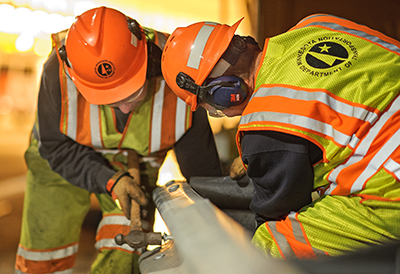
A MnDOT crew fixes a guardrail on Interstate 94. MnDOT is required by law to try to collect for damage to state property by motor vehicle crashes. Photo by David Gonzalez |
Motorists in Minnesota damage millions of dollars’ worth of MnDOT-owned property every year due to motor vehicle crashes. If anyone damages state property, such as bridges, signs, guardrails, jersey barriers, light poles, noise walls, landscaping, electrical cabinets and MnDOT fleet vehicles, they are liable for that damage. The most commonly damaged property is guardrails, with signs next. MnDOT is required by law to try to collect monies owed to the department resulting from these incidents.
“One of the most expensive accidents was a truck carrying a backhoe that hit the Xerxes Avenue Bridge, crossing Interstate 494,” said Matt Gaetz, state program administrative coordinator. “The $500,000 cost of this accident was all paid back to MnDOT by the trucking company’s insurance company.”
In a typical crash, law enforcement, including State Patrol, responds to the scene, gathers driver/owner information along with their insurance, places a yellow tag on any damaged MnDOT property, and then files an accident report. The report also indicates the property type and location. Upon request, the State Patrol distributes the reports to appointed damage claims representatives in each district.
In most cases, the district will repair the damage and provide a claim with the detailed costs to the Financial Operations section in MnDOT's Office of Financial Management. Financial Operations creates an invoice in SWIFT and files a claim against the driver/owner’s insurance. If the driver/owner is not insured, they invoice the responsible party. The money collected is deposited to the special damage restitution budget for the district/office in which the damage occurred.
If the responsible party does not make payment arrangements, is not insured, and is also being prosecuted for an underlying criminal offense (DUI, driving without insurance, reckless driving, etc.), MnDOT will seek court-ordered restitution when the individual is sentenced for the crime.
If the debt remains past due, MnDOT must refer the debt to the Department of Revenue for collection. DOR will attempt to collect the debt for up to six years.
In fiscal year 2015, MnDOT processed and closed a record 4,150 claims and collected $7,659,062 on those claims. DOR also collected an additional $252,432 on debts MnDOT referred to them for collection.
For additional information on damage restitution, contact Matt Gaetz or Jane Marah. |
 |
|
| |
|



